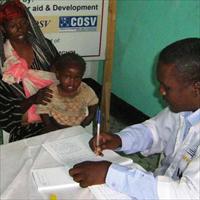KENYA: Isolation wards vital in TB fight

Five months after a specialised facility for multi-drug resistant Tuberculosis (MDR-TB) patients was established at Kenyatta National Hospital in Nairobi, the lack of isolation wards is raising concerns.
"This is not the best place; TB is a highly infectious disease,” Catherine Koskei, a matron working at the facility, told IRIN. “The patients need to be restricted.”
Patients make daily visits to the centre, a tent in an open field in the hospital grounds, where natural ventilation and ultra-violet rays help to neutralise the infected air, Koskei said.
However, isolating patients for the duration of the treatment could significantly control the spread and help manage the strain, according to Henderson Irimu, head of HIV/TB treatment care and the MDR-TB programme at the hospital. "We need to prioritise isolation facilities."
Resistance
MDR-TB occurs when patients develop resistance to Rifampicin and Isoniazid, the two most powerful anti-TB drugs. According to a World Health Organization (WHO) report, Kenya recorded at least 130,000 new TB cases in 2007, while Médecins sans Frontières estimates there are 250 MDR-TB cases.
Since MDR-TB is highly infectious, patients and staff have to wear protective respiratory masks for the duration of the treatment. Some patients are forced to wear them in public.
“People are not used to the masks, they look at [us] suspiciously and they are scared.” Titus Kyalo, one of 25 MDR-TB patients receiving treatment, said.
He has been forced to make adjustments at home. “My wife sleeps in a different room; at dinner time, I normally eat before the others; I also use my own utensils.”
Walter Orina, 31, commutes daily from Kayole, in the eastern part of Nairobi.
“In April 2004, I had a fever, I thought it was malaria; when I was diagnosed they [doctors] told me I had TB,” Orina said.
He was on medication for eight months. “I got cured, I thought I was okay.”
However, two months later, he was sick again - he had contracted MDR-TB.
“I had read some articles [on MDR-TB]. I got frustrated, discouraged,” he said, adding that the MDR-TB drugs were expensive. Luckily, he found out they were being provided for free at the centre.
A full dosage of the drugs used for second-line treatment costs the government at least Ksh1 million (US$13,000) for each patient, according to Irimu.
The project is supported by the Green Light Committee of the WHO and the Global Fund to fight AIDS, Tuberculosis and Malaria.
The patients receive drugs and an injection every day under Direct Observed Therapy (DOT) by a healthcare worker.
“The treatment goes on for 18 months; it could extend to two years because it is difficult to cure,” Irimu said.
He added that if not properly treated, the illness could result in surgery. “We look at the badly destroyed areas in the lungs and remove them.” Three patients on the programme have died.
Stigma
“People started pointing fingers at me, this one has AIDS, this one will die in one week,” Lucela Gatimba, 26, another patient, said. “Some of my relatives stopped visiting our home, I saw myself as worthless.”
Although the condition of most patients is improving, side-effects are an issue. “My legs are weak because of the injections, I am often drowsy,” Kyalo said.
“They [patients] suffer from nausea and abdominal pains,” Liesbet Ohler of MSF, said, adding that others experienced hallucinations and depression.
MSF is providing treatment to 14 MDR-TB patients at Blue House in the Mathare slums in Nairobi. Ohler said 43 patients were on treatment and about five had been cured.
According to WHO, poor drug usage, interruption of treatment and infection by MDR-TB patients are some of the major causes of the strain.
HIV/AIDS and poverty also play a role. “TB as well as MDR-TB is a disease of the poor,” Ohler told IRIN. “They live with a lot of people in badly ventilated houses and rooms without sunlight, which is the perfect fit to pass TB from one person to another.”
Strengthening health systems, providing isolation facilities, opening more MDR-TB care centres, creating awareness, and better management of MDR-TB patients by healthcare workers are vital to help stem the spread of the strain, Irimu said.
No cases of extensively drug resistant TB (XDR-TB), a more severe strain, whereby the disease develops resistance to the second line treatment, have so far been reported.
 Back and Next - Back and Next
Back and Next - Back and Next See Also - See Also
See Also - See Also